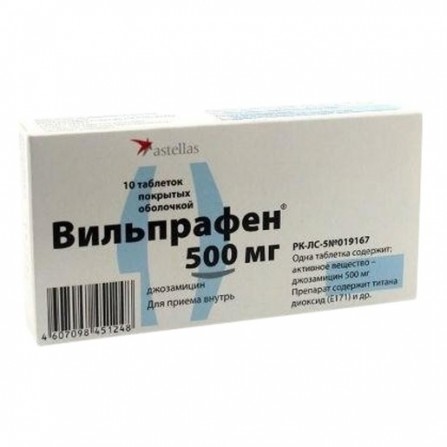More info
Active ingredients
Josamycin
Release form
Pills
Composition
1 tablet contains: josamycin 500 mg, excipients: methylcellulose, MCC, anhydrous colloidal silicon dioxide, polysorbate 80, sodium carboxymethylcellulose, talc, magnesium stearate, macrogol 6000, titanium dioxide (E171), aluminum hydroxide, poly (ethacrylate methylmethacrylate) - 30% dispersion
Pharmacological effect
An antibiotic group macrolides. It has a bacteriostatic effect due to inhibition of protein synthesis by bacteria. When creating in the focus of inflammation of high concentrations has a bactericidal effect. Highly active against intracellular microorganisms: Chlamydia trachomatis and Chlamydia pneumonuae, Mycoplasma pneumoniae, Mycoplasma hominis, Ureaplasma urealyticum, Legionella pneumophila; against gram-positive aerobic bacteria: Staphylococcus aureus, Streptococcus pyogenes and Streptococcus pneumoniae (pneumococcus), Corynebacterium diphtheriae; gram-negative aerobic bacteria: Neisseria meningitidis, Neisseria gonorrhoeae, Haemophilus influenzae, Bordetella pertussis; against some anaerobic bacteria: Peptococcus, Peptostreptococcus, Clostridium perfringens. Josamycin is also active against Treponema pallidum.
Pharmacokinetics
After oral administration, josamycin is rapidly absorbed from the gastrointestinal tract. Сmax is reached in 1-2 h after administration. 45 minutes after administration of a dose of 1 g, the average plasma concentration of josamycin is 2.41 mg / l. Plasma protein binding does not exceed 15%. The equilibrium state is reached in 2-4 days of regular intake. Josamycin is well distributed in the body and accumulates in various tissues: in the lung, lymphatic tissue of the palatine tonsils, organs of the urinary system, skin and soft tissues. Especially high concentrations are found in the lungs, tonsils, saliva, sweat and tears. The concentration of josamycin in human polymorphonuclear leukocytes, monocytes and alveolar macrophages is about 20 times higher than in other cells of the body. Josamycin is biotransformed in the liver to less active metabolites. Excreted mainly with bile, excretion with urine is less than 20%.
Indications
Infections (including chlamydia, mycoplasma and mixed) of the respiratory tract and ENT organs (sore throat, pharyngitis, otitis media, sinusitis, laryngitis, tonsillitis and paratonsillitis, acute bronchitis, pneumonia, (including atypical form). skin and soft tissues (pyoderma, furunculosis, anthrax, erysipelas (with increased sensitivity to penicillin), acne, lymphangitis, lymphadenitis, venereal lymphogranuloma).urinary system (pyelonephritis, prostatitis, chlamydia, mycoplasmosis, ureaplasmosis, gonorrhea, syphilis). dental infections (gingivitis, periodontal disease). in ophthalmology (blepharitis, dacryocystitis). diphtheria (in addition to treatment with diphtheria toxoid), scarlet fever (in the case of hypersensitivity to penicillin), whooping cough, psittacosis.
Contraindications
Hypersensitivity, severe abnormal liver function, prematurity. Precautions should be prescribed against the background of renal failure.
Precautionary measures
On the part of the digestive system: rarely - lack of appetite, nausea, heartburn, vomiting, diarrhea, pseudomembranous colitis; in some cases - increased activity of hepatic transaminases, a violation of the outflow of bile and jaundice.
Use during pregnancy and lactation
Use during pregnancy and lactation is possible only in cases where the intended benefit to the mother outweighs the potential risk to the fetus or child. In the treatment of macrolides and the simultaneous use of hormonal contraception should be further used non-hormonal contraception.
Dosage and administration
Inside, pills - without chewing, drinking down with a small amount of water, the suspension is prescribed between meals (the contents of the vial are pre-shaken): 1-2 g per day in 2-3 doses. The duration of treatment of streptococcal infections is at least 10 days. For the treatment of common and spherical acne - 500 mg 2 times a day for 2-4 weeks, then 500 mg 1 time per day for 8 weeks. Newborns and children up to 14 years old - 30-50 mg / kg per day in 3 divided doses.
Side effects
On the part of the gastrointestinal tract, it is seldom - loss of appetite, nausea, heartburn, vomiting, dysbiosis, diarrhea. In the case of persistent diarrhea, one should keep in mind the possibility of life-threatening pseudomembranous colitis developing against the background of antibiotics. Allergic reactions in extremely rare cases are urticaria.
Interaction with other drugs
Bacteriostatic antibiotics can reduce the bactericidal effect of other antibiotics, such as penicillins and cephalosporins (concurrent use of josamycin with penicillins and cephalosporins should be avoided). With simultaneous use of josamycin with lincomycin may reduce the effectiveness of both drugs.Josamycin slows down theophylline elimination to a lesser extent than other macrolide antibiotics. Josamycin slows the elimination of terfenadine or astemizole, which increases the risk of life-threatening arrhythmias. There are separate reports of increased vasoconstrictor action with simultaneous use of macrolide and ergot alkaloids. There is 1 case of ergotamine intolerance while taking josamycin. With the simultaneous use of josamycin and cyclosporine, it is possible to increase the concentration of cyclosporine in the blood plasma up to nephrotoxic. With simultaneous use of josamycin and digoxin may increase the level of the latter in the blood plasma. In rare cases with macrolide treatment, the contraceptive effect of hormonal contraceptives may not be sufficient.
special instructions
In the case of pseudomembranous colitis, josamycin should be canceled and appropriate therapy should be prescribed. Drugs that reduce intestinal motility, are contraindicated. In patients with renal insufficiency, correction of the dosage regimen is required in accordance with the CC values. Josamycin is not prescribed to premature babies. When used in newborns, it is necessary to monitor liver function. Consideration should be given to the possibility of cross-resistance to various macrolide antibiotics (for example, microorganisms that are resistant to treatment with antibiotics related to chemical structure may also be resistant to josamycin).






